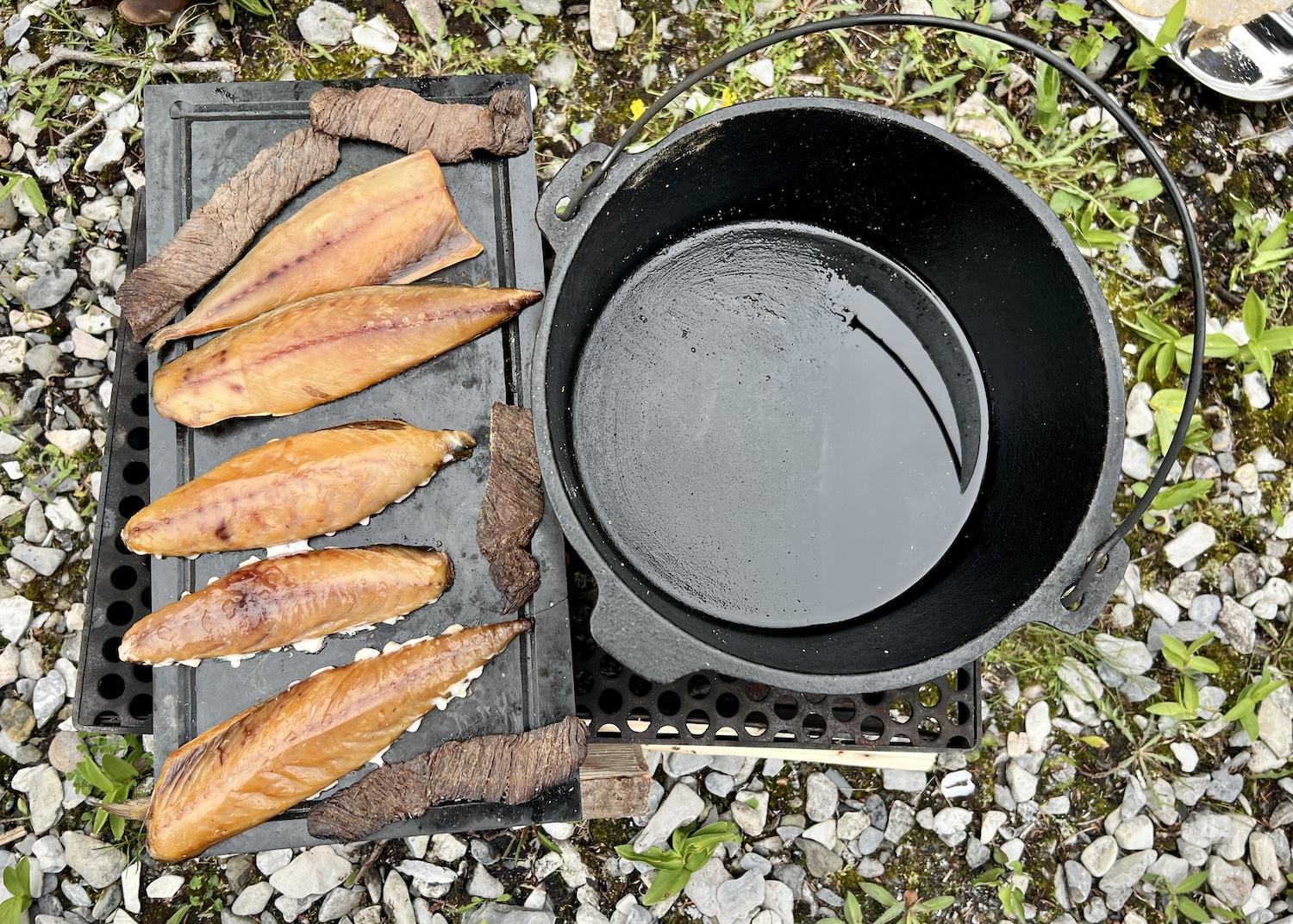
On the Discover Mekapisk outing with Gros Morne Adventures, marinated moose and smoked mackerel are warmed up at a campfire (in a firebox) at an isolated cove/Jennifer Bain
Our journey back in time begins with a quick trip across Bonne Bay to an isolated cove where we will have important work to do. The work will be mental, not physical, and will end with a campfire and meal.
“The First People came here, probably by birch bark canoe, but we are going to go by Zodiac and just imagine paddling the canoe,” Keith Payne tells my family of four and two of his visiting relatives. “We’ll pretend here that we’re the first people ever to come here. We’ve got to decide if we’re going to stay.”
What do we need to survive? Can we find it here? Is it enough for a weekend, a week or longer?
“Let’s make this a discussion rather than a lecture from me,” Payne suggests.
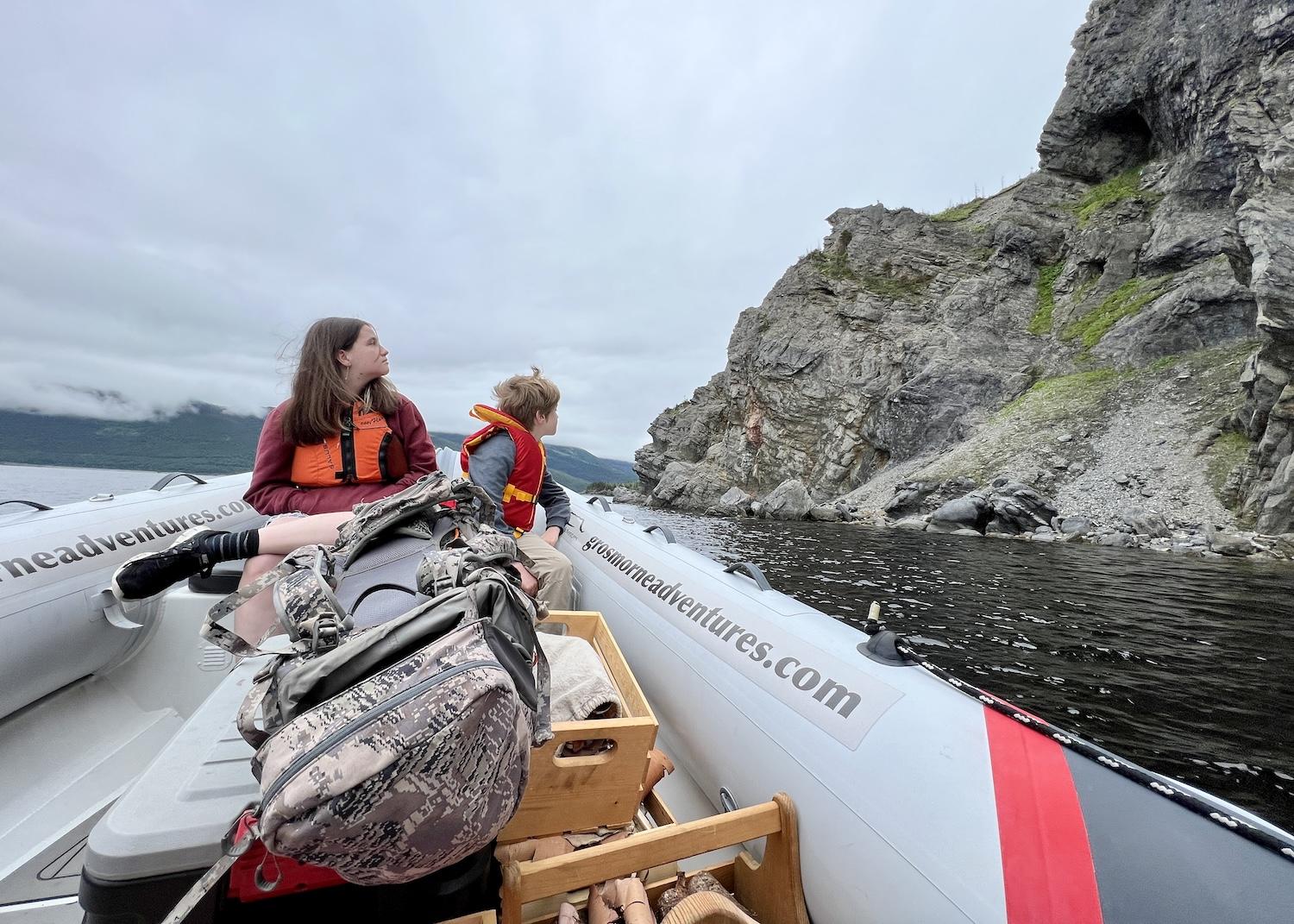
Gros Morne Adventures takes guests by boat to an isolated cove for an Indigenous experience called Discover Mekapisk/Jennifer Bain
We’ve come to modern-day Gros Morne National Park in July for what's celebrated as the park’s first Indigenous tour. Launched in 2019, this immersive, three-hour experience is called Discover Mekapisk — Mekapisk being Mi’kmaq for Long Range Mountains, the part of the Appalachian chain that cuts through the park.
We weren't taught Indigenous history when I was in school, but my kids have been learning it since kindergarten and know that Newfoundland and Labrador is home to three distinct groups.
In Labrador, the Inuit are descendants of the Thule while the Innu are descended from Algonkian-speaking hunter-gatherers. The Mi’kmaq, meanwhile, have lived and traveled throughout the island of Newfoundland for generations. But Newfoundland joined Confederation in 1949 without recognizing Mi’kmaq communities as First Nations under the Indian Act. It wasn’t until 2008 that the Qalipu First Nation, a “landless band” of Mi’kmaw living across the province instead of on reserve lands, was recognized. It’s now coping with a slew of membership applications.
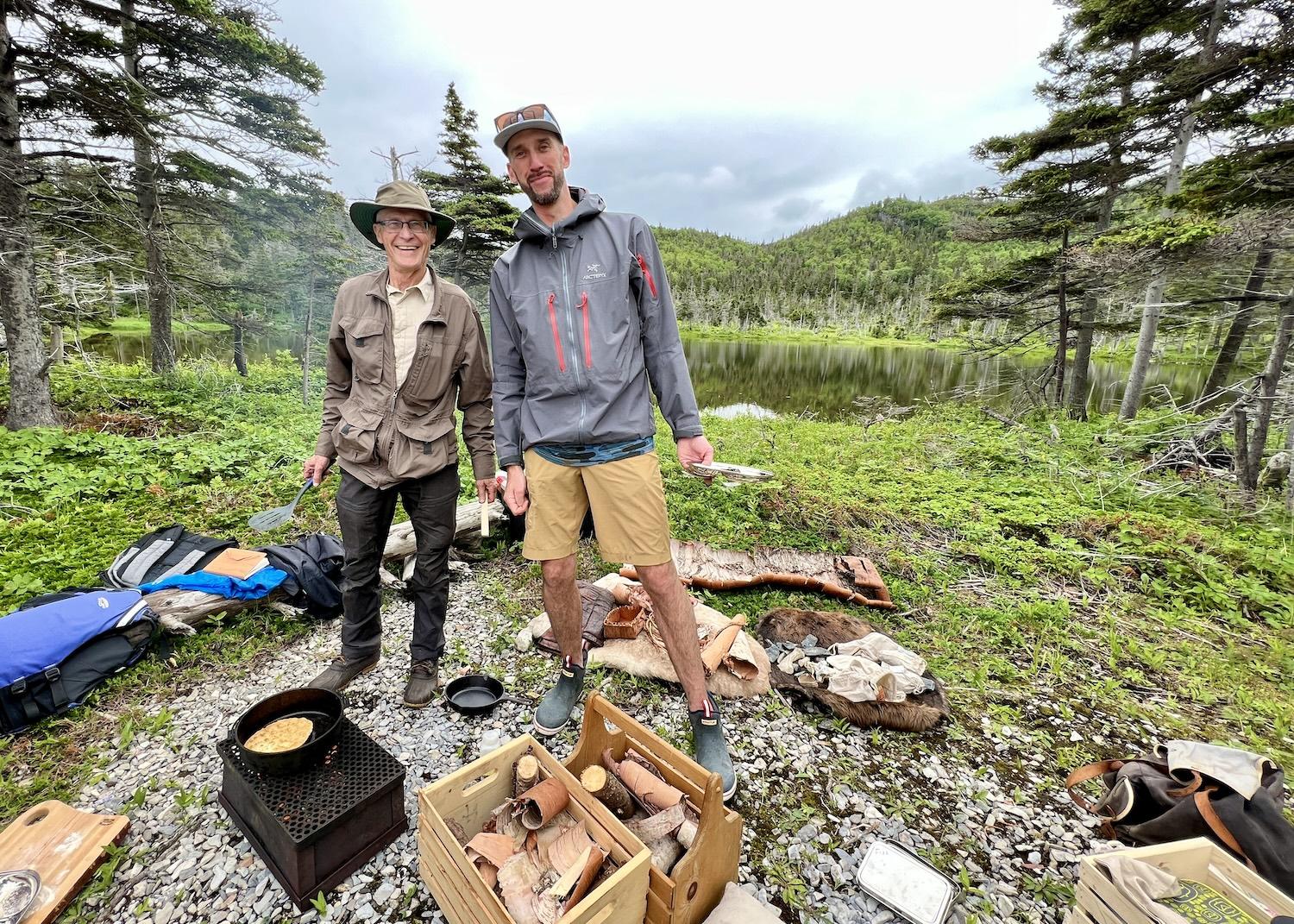
Robbie Hickey, right, co-owns Gros Morne Adventures with his wife Kristen, whose father Keith Payne, left, is the guide for its Indigenous experiences/Jennifer Bain
Indigenous tourism is just getting started in the province, and Gros Morne Adventures offers this outing with its roster of small group hiking tours, sea kayaking and backpacking adventures. "We wanted to create an Indigenous experience that supports our family values by sharing our appreciation and respect of our natural resources and seasonal way of life," explains Kristen HIckey, who owns the business with her husband Robbie.
Payne is Kristen’s dad and a member of the Qalipu First Nation who lived in the park’s main town, Rocky Harbour, until he was 10. Today, as our guide, he will focus on the ancient human pre-history of the area — history being something written down and pre-history being something we surmise based on archaeological evidence. Just three hours from here at L’Anse Amour National Historic Site in Labrador there’s evidence of a distinct culture that dates back 7,500 years. Around here, there’s evidence of five successive Indigenous cultures that date back 4,000 to 5,000 years.
Discover Mekapisk runs June to October and there's another Indigenous experience that involves paddling a traditonal 10-person canoe. We're grateful to be in a Zodiac with Robbie and Payne. Our boat flies across the tickle — Newfoundland dialect for a narrow saltwater strait — of a double-armed fjord from Bonne Bay into East Arm and land in Stores Cove. Because of climate change, we learn, this harbor almost never freezes over these days.
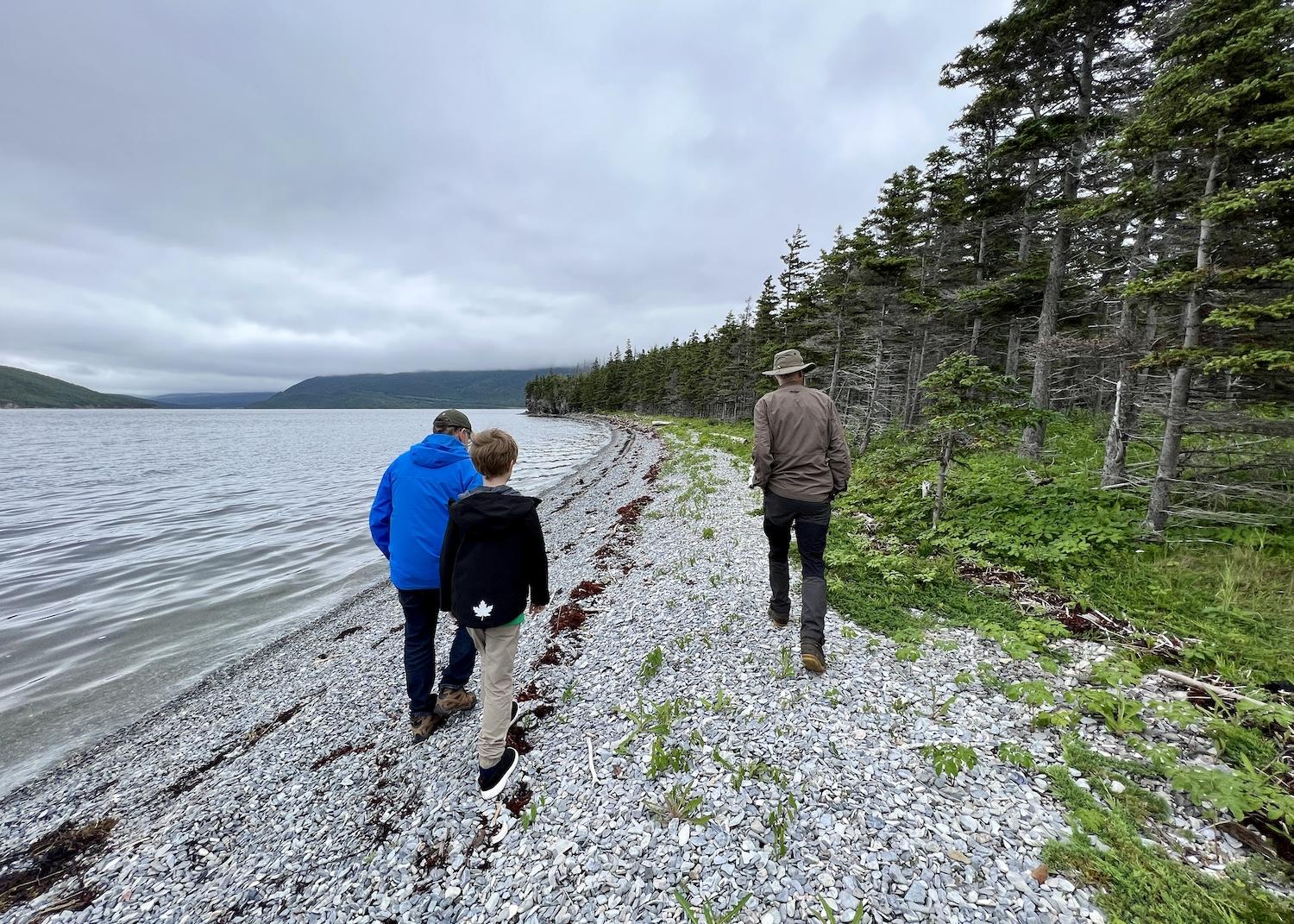
Gros Morne Adventures guide Keith Payne leads Discover Mekapisk guests on a rocky beach walk while getting them to see the land in what's now Newfoundland and Labrador as the First Peoples might have thousands of years ago/Jennifer Bain
“We’re ready to start this imaginary journey,” says Payne. “We’re imagining we are the first persons here. We’ve paddled in birch bark canoes and landed. Will we go tomorrow or stay?”
The winters would have been challenging. There obviously wouldn’t have been grocery stores, pharmacies, hardware stores or hospitals. We will need fire, food, shelter, water and more.
We wander from the beach to a pond, pick up a stick that has been gnawed on by a beaver and talk about how this herbivorous mammal signals there’s fresh water to be found. We look to the ocean and talk about salmon, capelin, mussels and clams. We hear birds and talk about harvesting eggs.
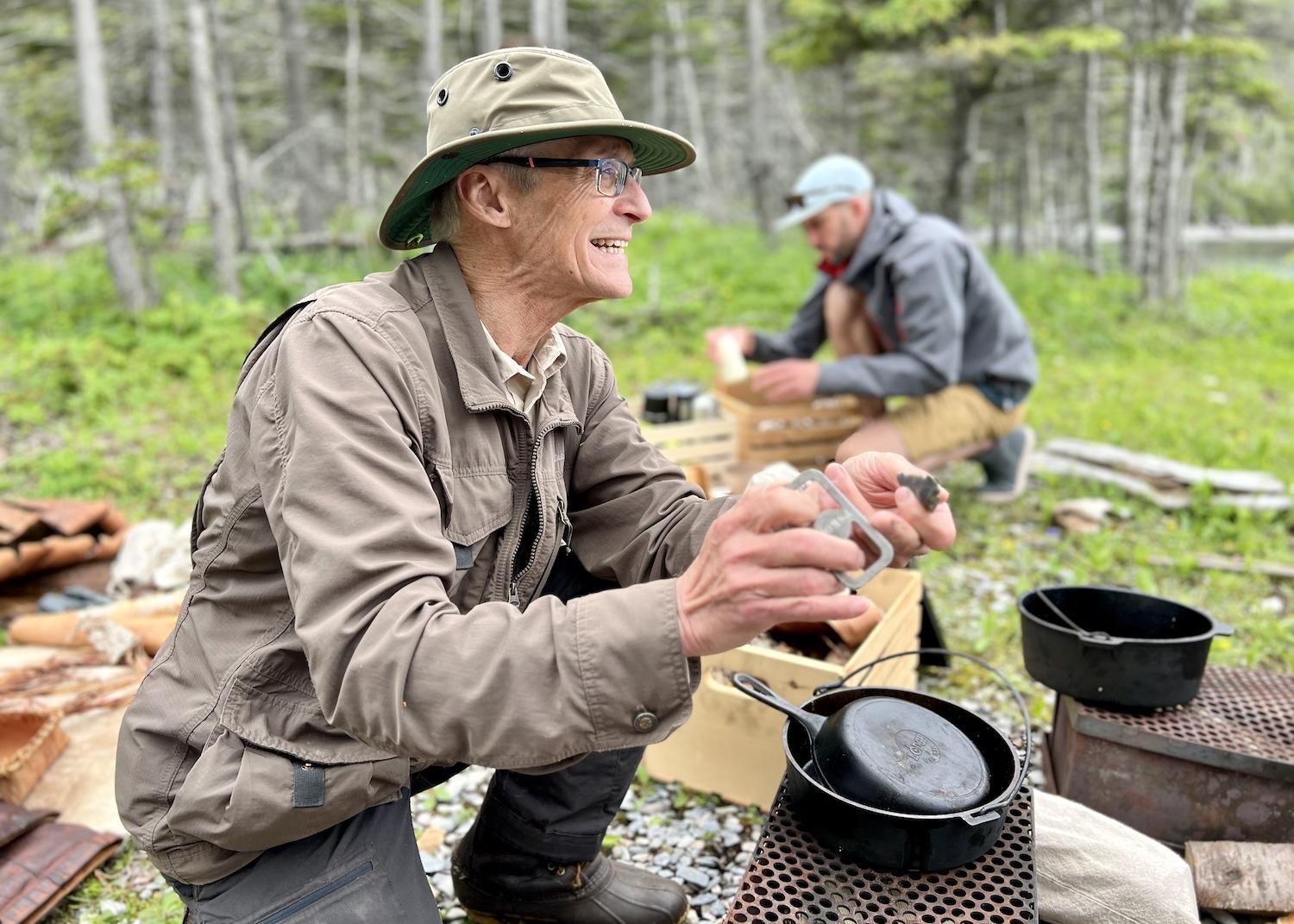
Gros Morne Adventures guide Keith Payne holds a piece of flint (chert) in his left hand while showing how his ancestors started fires/Jennifer Bain
Then we follow a game trail up a steep path in the woods to a lookout while talking about the plants and animals — like caribou, whales and seals — that sustained early life here. On our way back down, Payne points out some pieces of chert embedded in other rocks that can be used to start fires and make things like knives and arrowheads.
“It was so important, it was almost like money,” he says.
From what we can tell, this seems like a fine place to live — at least in summer.
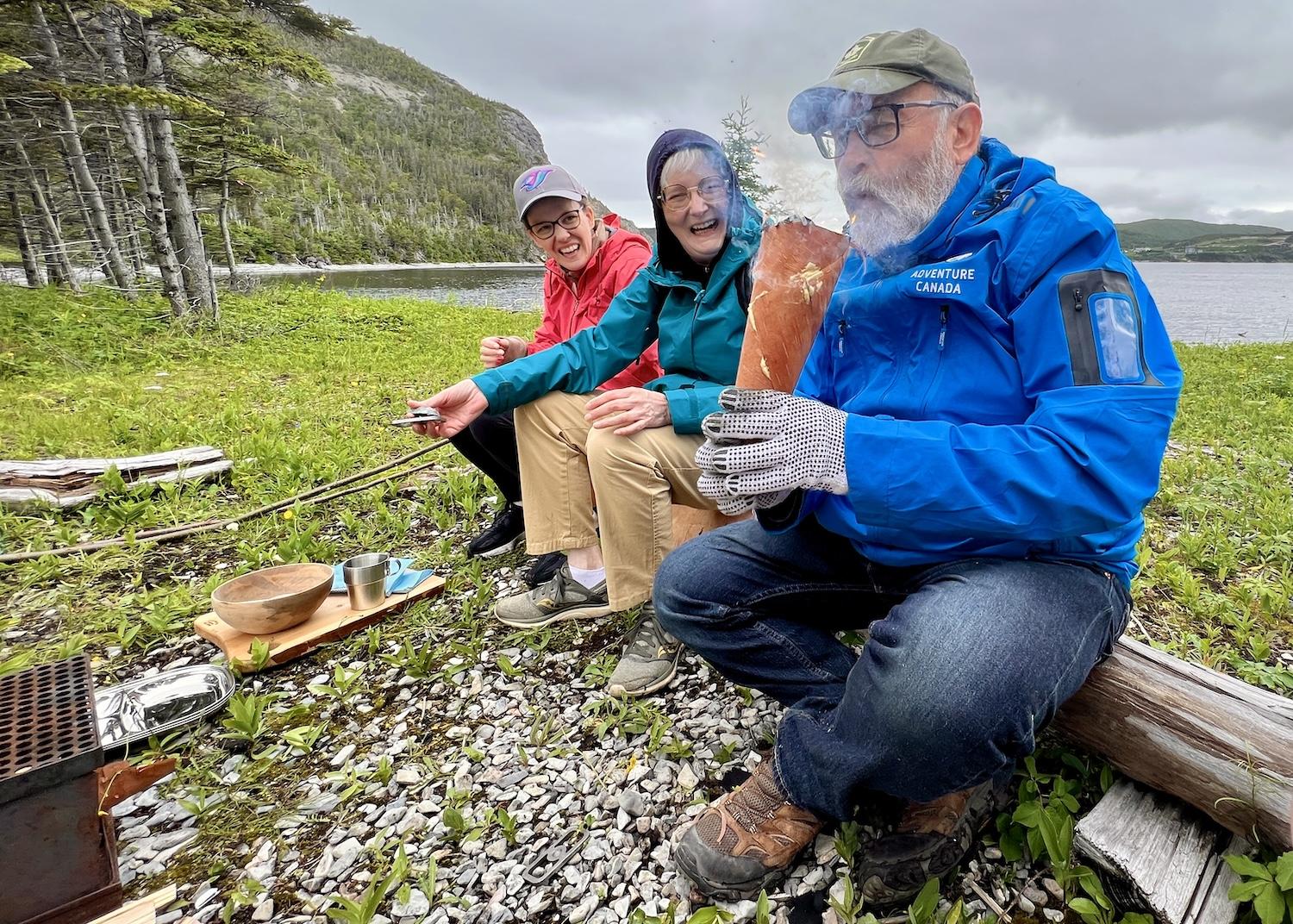
Rick MacKenzie blows on a flame lit inside a cone of birch bark by using a flint made of Ramah chert/Jennifer Bain
Now it’s time to eat and so we gather around a small black box for a “campfire.” But first we must use a piece of chert as flint to start our fire. It’s much harder than it sounds when you’re used to just using a barbecue lighter or match.
“Way to go guys — we’ve got fire,” says Robbie when we eventually succeed. He explains that you can’t usually have an open fire in a national park, but Payne found a firebox that was approved in Nahanni National Park Reserve (a remote park in the Northwest Territories that's known for white water river trips) and got a special permit from Parks Canada to use it here.
Finally it's time for the cush part of our outing. We don't have to source our own food. Instead, our guides unpack a small feast of traditional Indigenous foods like smoked mackerel, maple syrup marinated moose (from an animal the men harvested), and dough for lu’skinikin (bannock).
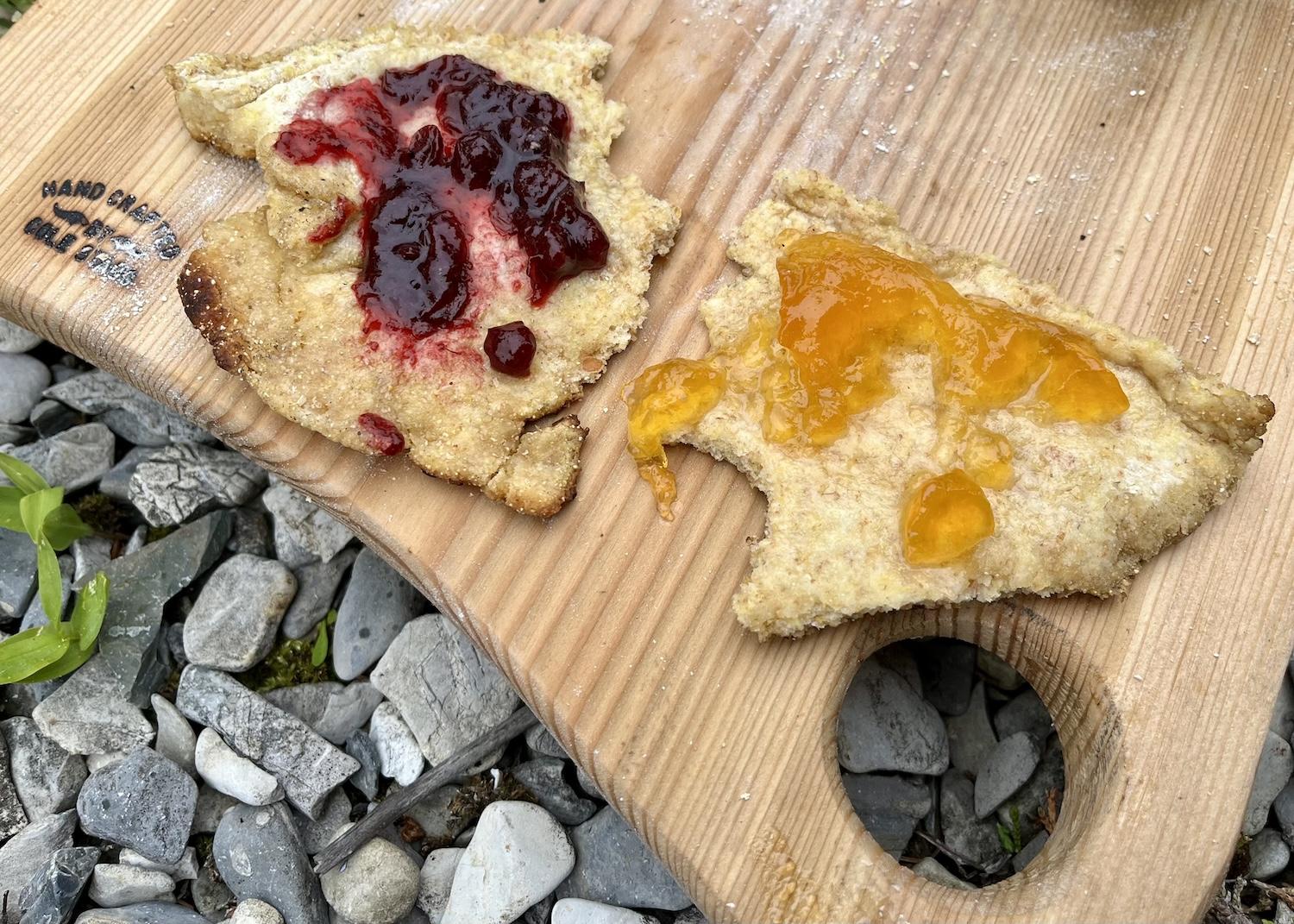
Keith Payne's version of bannock is served with local Newfoundland preserves (partridgeberry and bakeapple)/Jennifer Bain
Yes, bannock was introduced by the Europeans, but Indigenous communities in Canada have embraced it and made it their own, using different ways of frying, baking and roasting it and slightly different recipes. Being able to make this quick bread is also “a very, very good camping and wilderness skill,” Payne adds.
His recipe is more robust than I’m used to because there’s whole wheat flour, wheat germ, wheat bran and cornmeal in the mix with the usual baking powder and salt. But the principle is the same — combine your flour and other dry ingredients, add water, make a snowball and then flatten it into a rough pancake.
Today's bannock is cooked in a cast-iron skillet and we get to slather it with local bakeapple and partridgeberry preserves. Anyone who has spent time in this province knows about these beloved wild berries, one yellow and also called cloudberry, the other red and known internationally as lingonberry.
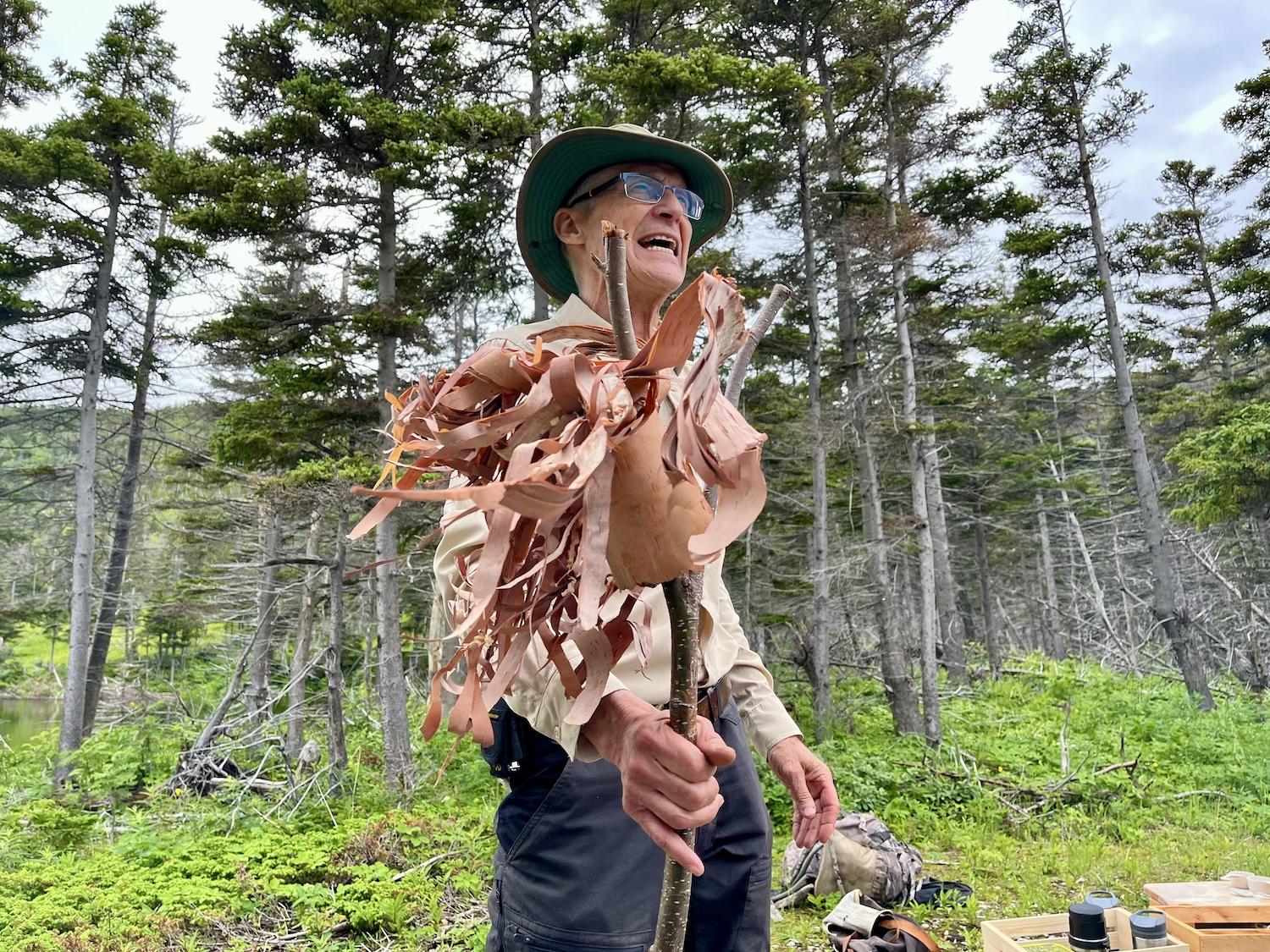
Gros Morne Adventures guide Keith Payne shows off a torch/lantern made of birch bark/Jennifer Bain
Our bellies full, the talk becomes more personal as Payne shares details about his family's journey to embrace its ancestry.
Finally, he lays several treasured objects on a caribou hide. We marvel at the ingenious designs of sealskin boots and the way birch bark has been dried and transformed into a waterproof basket, lantern/torch and hunting horn. We stroke a wiry beaver pelt and my kids play with an Inuit toy crafted from two seal bones — a vertebrate and a sliver of the shoulder blade tied together.
On the surface, we have looked at this bountiful land through the eyes of the First People as instructed. But Payne has also succeeded in quietly ensuring we “look at the First People with different eyes” and see how smart, creative and resourceful they have always been.
More Indigenous Connections:
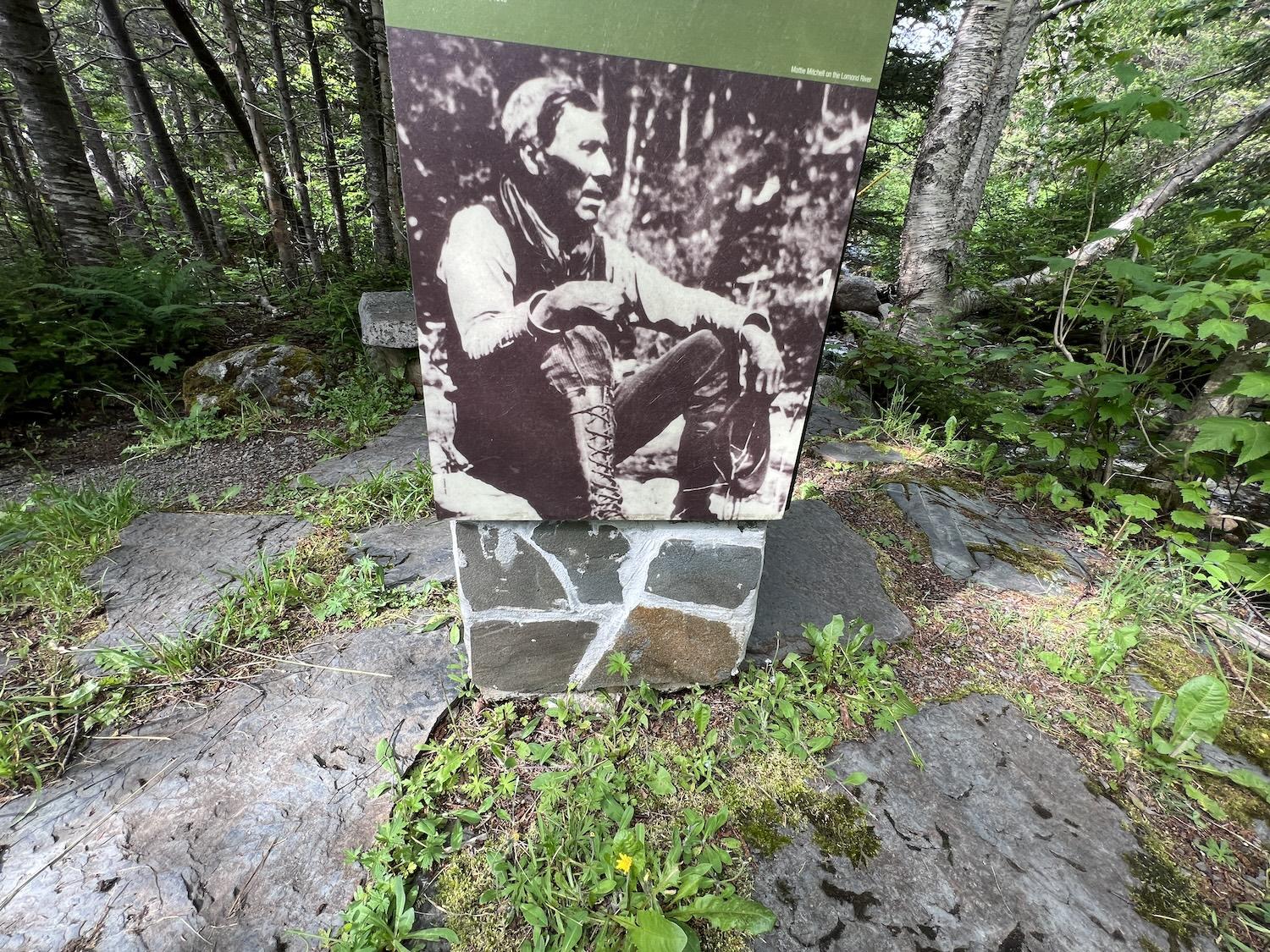
On the Mattie Mitchell Trail in Gros Morne National Park, interpretive panels share the story of the renowned Mi'kmaq hunter, guide and prospector/Jennifer Bain
As Parks Canada reminds us, oral tradition holds that Indigenous peoples continuously occupied the island of Newfoundland since prehistoric times. They hunted, fished and lived here long before European settlers arrived. Now many people celebrate their Mi’kmaq ancestry.
To help tell the Mi’kmaq story, the Gros Morne National Park Discovery Centre in Woody Point launched Miawpukek: The Middle River exhibition in 2021. Working with the people of Miawpukek First Nation, the exhibition by artists Pam Hall and Jerry Evans explores the stories and traditions of Conne River, a Mi’kmaw community of Newfoundland’s south coast.
Just south of the town of Rocky Harbour in Gros Morne, the Mattie Mitchell Trail tells the story of Mi’kmaq in Newfoundland and this renowned Mi’kmaw hunter, guide and prospector has been recognized as a person of national historic significance. Mitchell made an exceptional contribution to the exploration and mapping of the Northern Peninsula and to the development of the emerging economy of forestry and mining in the 20th century. He also guided Royal Navy officers who were on leave from patrolling the French Shore.
To get to Gros Morne, most people fly into Deer Lake Regional Airport. In between Deer Lake and the park, Upper Humber Settlement in Cormack offers a bed and breakfast farm stay experience. Owned by Lauralee and Mark Ledrew, the small-scale sustainable farm also welcomes people for permaculture farm tours, farm and forage tours, living off the land experiences, berry picking experiences and farm-to-table dinners. My family joined for the medicine wheel and fire circle experience, learning about Lauralee’s ties to the Qalipu First Nation and her journey to embrace her Mi’kmaq ancestry.
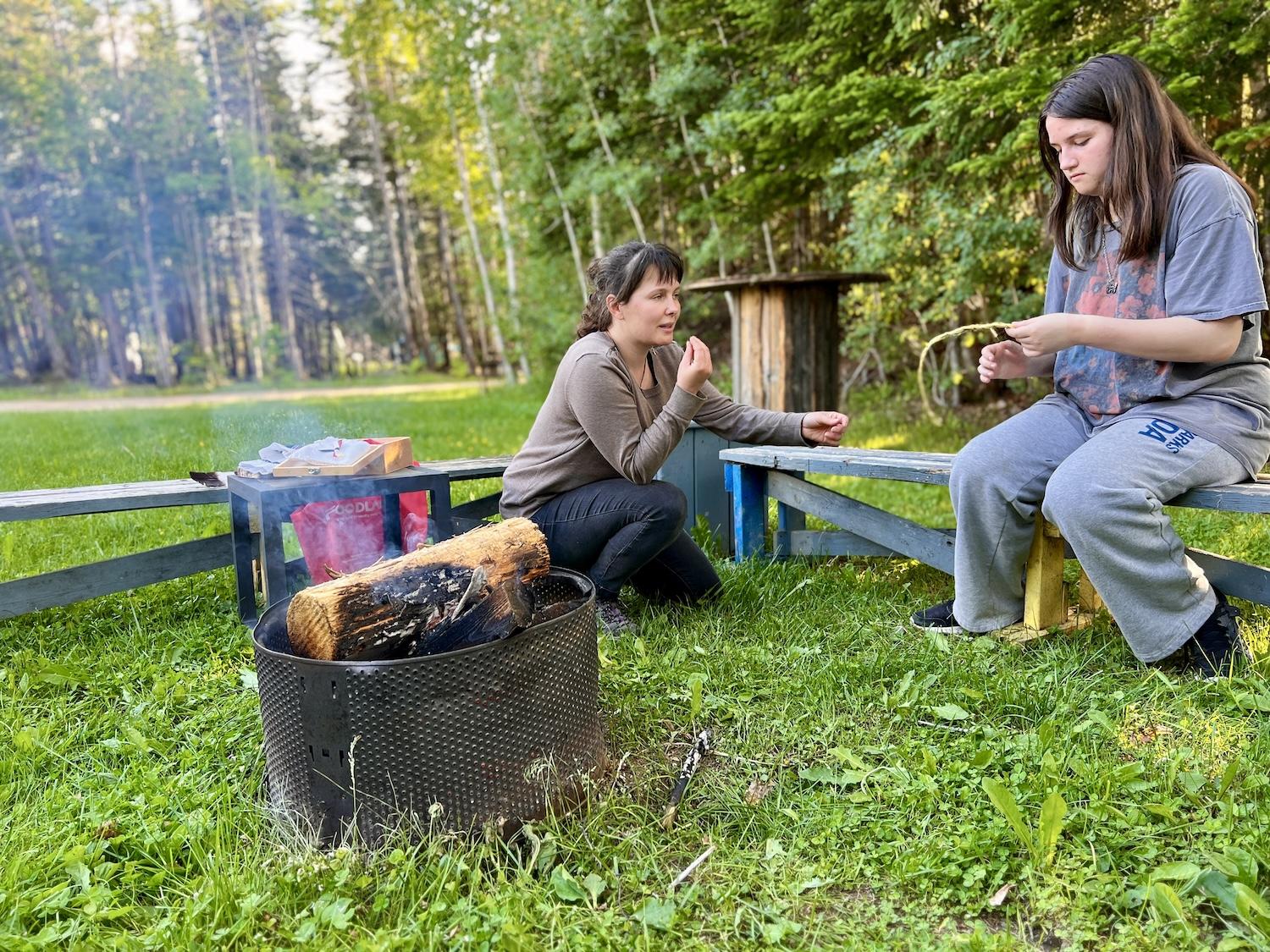
At Upper Humber Settlement, a farm stay bed and breakfast in Cormack, owner Lauralee Ledrew leads a medicine wheel and fire circle experience and shares her Indigenous ancestry/Jennifer Bain


